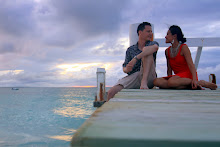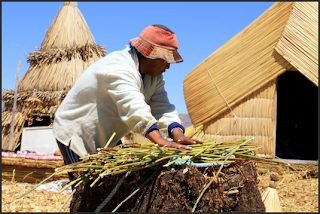
Today we take long distance bus for the six hour ride through Peru’s alti-plano to Puno, besides Lake Titikaka. This is mostly highland country, all above 11,000 feet, with miles of mud brick houses, and indigenous farmers in traditional dress and bowler hats attending their cows, lamas, alpacha, and sheep. The little lamb are so cute!
Sept 24 Puno
Today we take a really fun half day tour to visit the Oros people, who live in floating islands on Lake Titikaka. These people are pretty hard core; making floating islands, houses, and boats out of reed straw which grows around the shallows of the lake. Apparently this was their method of achieving independence from the Incas, as no one bothered them on the lake.
The floor of the island is extremely soft, kind of like walking on a straw water bed. It’s pretty much guaranteed that none of the islanders have knee problems. The people are really friendly and invite us into their homes to try on traditional dress, and take pictures. A little girl of about three picks up her little brother to show him off for pictures. He is so fat, that she can barely carry him!
One of the islander’s demonstrates how to create a floating island. Afterwards, the ladies demonstrate market bartering, which is really funny. The ladies sit in a circle all talking at the same time; pulling items out of each other’s bowls and smacking each other on the head when the trading get unfair.
We ride a reed boat to another island. On departure, the islanders sing songs in Spanish, English, and German, and then conclude with “Hasta La Vista, Baby!”
In the afternoon, we visit the tiny coca museum in Puno. First, there is a video describing the various traditional dances in Peru. The dances use elaborate costumes with locals as slaves triumphing over the greedy devilish Spanish, through faith and hard work.
The museum also includes a historical account of the coca leaf; pre-Inca times, early twentieth century medicine, Coca-Cola, and cocaine. Apparently, the coca leave contains many vitamins, and minerals, and chewing the leaf is important for energy, health, and preventing tooth decay.
For dinner, we tire of the Peru tourist menu, and go out for pizza. We usually avoid gringo food, but the wood fired pizza is really delicious; almost Monster Kid quality (Kevin's college buddy makes a tasty pizza). Also the wood fired pizza restaurants are nice and warm inside. Above 11000 feet, it’s cold at night!
CLICK HERE to see Lake Titikaka pictures





















10 comments:
Sweet, a monster kid mention!! I'm actually going to fire up my oven soon. It's getting cool in SB, so my house heating oven is appropriate again...
Hi Guys
At first I wasn't sure what I was seeing, and then I saw your pictures and went back and through everything. What a gorgeous and unique and wonderful opportunity you two are taking at this juncture of your lives to be traveling, learning, and enjoying in places that might be much more difficult with children or at a different cycle of life. I applaud you for what you are doing.
I know B.J. and your Dad loved to travel; we did our share as single gals a long time ago, and undoubtedly, your parents instilled this love of travel to you as well. I know Chris's wedding is scheduled for next month in Costa Rica, I believe. Hope your Dad is doing well; I will call him again soon, and from time to time. Thanks so much for sending these on, and would appreciate staying in touch with you.
Love,
Barbara Rabke
i don't have that much red sauce laying about, only 12 quarts or so.
(last year i ended up with 30, i think). but the season isn't done
yet, so we'll see. but it's actually been pretty chilly here already,
so maybe the season is done. it's confusing.
i've been making hot sauce a bit lately (basically peppers, vinegar,
salt). it's fun.
loving your blog...
Seth
真是个奇怪的岛,令人惊叹!居然会用芦苇建岛、建房,而且生活着一大堆人!
陈至诚
亲爱的笑笑:
又看见你灿烂的笑容真好!湖光山色也非常美丽!我怎么看,怎么觉得南美的人像极了我们西藏的藏民。真的,不论是服饰还是肤色,甚至他们的小饰品,都跟我们的藏族那么像!我上次说的《藏地密码》那本书里,就讲了与此相连的一些事。太有意思了!
天慢慢凉了,你们在外多注意身体!
祝一切好!
小姨 10/22
笑笑, 凯文:
很高兴又分享到你们那么多精彩有趣的旅途照片。外面的世界真是很精彩, 马丘比丘在二千多米高的山巅用石头创建了一座神奇
殿堂。
Titikaka 湖又在高原上建起了神奇的浮岛水城, 而这里所有的材料尽都是芦苇。芦苇造的浮岛, 芦苇造的船, 芦苇造的辽望
台芦苇造的----- 一个芦苇世界。又好像进入了一个神话世界, 如果不是你们亲眼所见这一切, 很难想象出芦苇能造出浮岛;房子; 船
还有各种用具和玩具, 而且都做得非常精致。
上帝给了人无限的智慧, 人类真是太了不起, 什么样的环境都能生存, 还能创造出一
片意想不到的奇妙的,精彩的天地。
我当然还记得意大利美丽的水城。 那天, 当火车快驶进威尼斯站时, 我从窗口看见铁轨就浮在水面上, 非常惊讶!我们走出车站环
游在这座美而华丽的水城里时, 心中无比的震惊和赞叹! 太美丽了! 太神奇了! 就象七个小矮人在神话中的感觉, 眼前到处都是欣喜,
神奇。永远难忘。也非常感谢你和凯文带我旅游了欧州, 感受到世界的多彩,美丽。
高原的气候怎么样,凯文身体好吗? 高原反应受得了吗? Erine 和你们在一起不要再去高原了。好好照顾他,代我问候他好。
愉快 健康
妈妈
如果您无法查看图像,请浏览我们的博客。
9月23日, 库斯科(Cosco)到普诺 (Puno)
一早,我们离开库斯科坐6个小时的长途大巴去普诺城。普诺是高原地带,以Titikaka湖出名。沿路看到当地居民的泥砖屋和他们的民族传统服饰:他们带着圆顶礼帽,穿着五艳六色的衣裙,在草原上看牛,羊,喇嘛,和alpacha。小羊羔是如此的可爱!
沿路风光
爱草的小家伙
普诺到了
9月24日,普诺
上午,我们参观访问Titikaka湖和当地的奥罗斯人。Titikaka湖出名是因为 1)本湖是世界最高的湖泊之一,2)湖中的浮岛。这些浮岛都是奥罗斯人用湖中的芦苇草做的。岛,岛上的房子,家具,玩具,礼品,所有的建筑物,包括奥罗斯人用的船通通都是芦苇草做的。奥罗斯祖先在几百年前为了逃避印加帝国控制,逃避战争,而想到修建浮岛的方法来获得独立,因为没人有会到湖上去打扰他们。这个故事让我想起了意大利的威尼斯。公元453年,当时威尼斯当地的农夫和渔民也是为了逃避战争,为了获得自由而建立了今天的美丽水城(妈妈,你还记得吗?)。
浮岛的地板超极软,像在稻草水床上行走。凯文认为岛上的居民一定没有任何膝盖问题。岛民们几乎不用纸钱,像狩猎和采集时期以物换物。他们很贫穷,但非常热情友善,邀请我们到他们家,试穿他们的传统衣服,拍照。一个大约3岁的小女孩想在照相机前炫耀她的小弟弟。他是个小胖胖,她几乎无法把他抱着走!
其中一个岛民演示如何创建一个浮岛。然后,妇女们表演她们如何在农贸市场以物换物做交易。她们表演得很逼真,实在是太好笑了。她们围坐讨论,如果有不公平的贸易时,她们就互相打对方的头。
我们乘芦苇船到另一个浮岛。离港时,岛民们唱西班牙,英语和德语歌曲给我们送行。
收获芦苇
工具刀剪断
用浮动的泥根块做低
把好多块泥根低用绳子栓一起
安装芦苇地板
最后,在岛上建房屋
准备开放农贸市场
加入新家庭
可爱的姐姐和胖小弟
送行!
下午,我们走访普诺博物馆。看了一个录影带描述秘鲁各种传统舞蹈和民族服装。聪明秘鲁少数民族以舞蹈来描述当地奴隶是如何战胜贪婪恶魔的西班牙侵越者,通过信念,奋斗,死亡,英雄的概念。我大专历史老师曾今说过 - 自由是努力奋斗获得的,而不是免费赠送的。
舞蹈服装
博物馆还包括对古柯叶的历史记录,前印加时代,20世纪初,医药,可口可乐,和可卡因。显然,古柯叶含有多种维生素和矿物质,以及嚼叶能增加能源,心脏健康,防止蛀牙。
古柯叶维生素和矿物质实表
前印加时代艺术文物展式当地人嚼古柯叶
晚餐,我们厌倦了每餐都吃秘鲁旅游菜单,决定去吃比萨!我们通常避免老外食物,劲量品尝当地食品。但从窗外看柴烧比萨饼真让我们流口水,在高原寒冷的夜晚能在柴烧炉子餐厅取暖吃比萨饼也很幸福呢!
比萨圆梦
点击这里查看Titikaka湖的图片
小姨,
南美大概分两种人口:1)土著人 和 2)欧洲人后代。
土著人就好比美国的印第安人。他们是南美印第安人。 在1.25和7万年前之间,人类从亚洲迁徙到现在美国的阿拉斯加越过白令海峡陆桥,以打猎为身的方法慢慢地迁徙到现在的南美洲。公元前5000年至2500年开始在南美洲现在的秘鲁定居农业发展。建立了主要的 印加帝国文明。
1492年, 西班牙人哥伦布在去印度的路上无意中发现美洲大陆。16世纪初,西班牙入侵整个拉丁美洲。印加帝国腐败,西班牙接管300年。 所以拉丁美洲的22国家都讲西班牙文。在这300年中,西班牙为了找金银财宝,杀死了很多当地的土著人,进口了非洲和亚洲奴隶。所以南美也有黑人和黄种人人口。1814年美洲大陆慢慢获得独立。
你看到的南美人是土著人,他们的祖先是亚洲人,所以像西藏藏民。 土著人口在北南美的国家比较多。阿根廷和智利的人口几乎都是欧洲人后代,没有土著人口。
笑笑
笑笑,
我欣赏了好多次你们的照片, 简直是太有趣了。你们象游览在童话世界中, 一会在石头之国, 一会在芦苇之国, 一会在山巅, 一会
在草原, 一会在海洋世界与鲸和鱼群共舞, 还有- - - 一切的一切, 我都无法想象, 而你们却都亲身经历, 亲眼目睹, 真是太幸福了。
古人说得好: 行万里路,如读万卷书, 相信你们也会学到很多知识。谢谢你们让我与你们一起分享, 因为有你们的照片和中文博客。
你和可爱的小姐弟一样可爱, 你们在芦苇之国加入的新家庭也很有趣。在其它国家呆了两个月, 当然,看到比萨饼就象看到川菜一
样, 口水都流出来了, 你们现在想到四川菜也会流口水吧?
很想你们, 问候 Erine。
Love & Miss
Mom
亲爱的的笑笑:
谢谢你告诉我南美的这些历史知识,让我又学到一些东西。这也再次说明,世界原本就是一家,人类需要和平。
祝你们一路平安!
小姨 10/26
Post a Comment